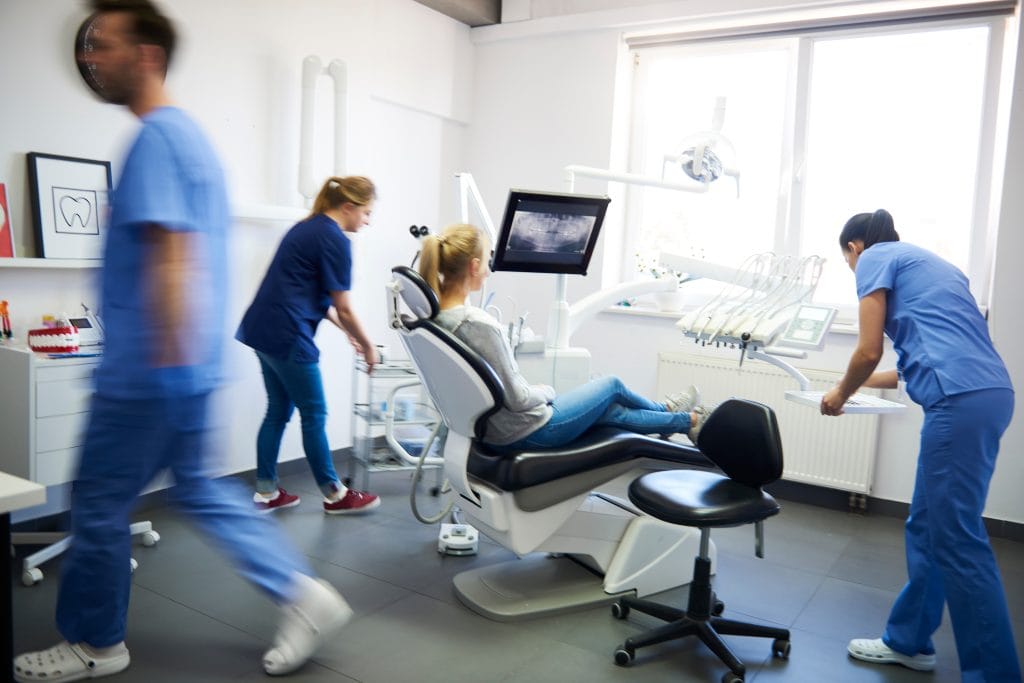 Is your practice extra busy after reopening from the COVID-19 shutdown?
Is your practice extra busy after reopening from the COVID-19 shutdown?
That’s great!
BUT…and I hate to be the bearer of “bad tidings,” this busyness now could give you a false sense of security about the future!
In many cases, this “busyness” from being back in the office has to do with catching up a “backlog.” Being so busy with backlogged patients leaves little time or attention for recall, reactivation or a focus on new patients.
Well…that’s your future production!
And depending on how you’re handing things, you may be in for a rude awakening when September rolls around and the schedule begins to empty out!
(Related: 7 Ways to Fill Openings in the Doctor’s Schedule)
And to that end, what I’m going to cover in this post mirrors what we’ve been teaching MGE clients. Our clients, while they were busy cleaning up the backlog also devoted time to ensuring that the future was just as busy. And by doing many of these things, according to reports from clients who reopened the earliest, our clients are still busier than EVER despite having sorted through the initial rush of backlogged treatment!
 And I know devoting time to anything but immediate patient flow right now is a lot to ask. Especially considering the added stress from implementing new requirements, longer procedure times, limited capacity, etc.—but, again, there are a few simple things you can do right now, to ensure you’re set up to stay productive after this backlog is done.
And I know devoting time to anything but immediate patient flow right now is a lot to ask. Especially considering the added stress from implementing new requirements, longer procedure times, limited capacity, etc.—but, again, there are a few simple things you can do right now, to ensure you’re set up to stay productive after this backlog is done.
And to add to this, the concern about COVID-19 hasn’t showed any signs of slowing down yet and many patients may be hesitant to come in for some time. So, you’ll need to reach out to more patients than ever now (new or patients of record) to keep your schedule consistently full.
So, with all of that in mind, here are four things you should start doing now:
1. Block out some time on your schedule each day for new patients, emergencies, and consultations.
I know it’s painful to leave open time on the schedule—especially right now. But it’ll be worth it in the long run. You need to be seeing new patients, reactivating patients-of-record, and getting patients with outstanding treatment to accept and schedule it.
(Related: 10 Tips for Scheduling Patients As Your Practice Re-Opens)
 If you do this right, that time won’t stay empty, it’ll be filled quickly—and the following points in this article will help you do that.
If you do this right, that time won’t stay empty, it’ll be filled quickly—and the following points in this article will help you do that.
And just as a backup plan, a smart Scheduling Coordinator will design the schedule so that even if that time doesn’t get filled as intended you can still use it productively. For instance, put a hygiene patient with outstanding treatment right before the open slot, so that if it’s still open you can get them started on their treatment immediately. Or put a second consult there.
Do you wish your Scheduling Coordinator was smarter about these things? Well, train them to be with our on-demand video training platform, DDS Success. The Scheduling Coordinator Training Course teaches them how to do all of this.
And if that time does wind up staying empty—that’s not necessarily a bad thing. The truth is, most patients coming in have some kind of outstanding treatment or something new to be diagnosed. So this extra time may give the doctor another 20-30 minutes to go over a patient’s treatment plan with them and get it accepted. They could spend more time on the hygiene exam and get that patient to finally start the 2 crowns they’ve been putting off for a year.
(Related: How to Turn Emergency New Patients into Great Long-Term Patients)
2. Devote time to recall and reactivation
Most dentists work on recall a little bit—they’ll occasionally reach out to active patients that need to be scheduled for hygiene—but they completely ignore older inactive patients. MGE Clients, on the other hand, dedicate time every single day to an effective program for scheduling active patients AND reactivating patients that haven’t been in for years. This is a big reason why MGE Clients are so much more productive than the national average.
So make sure someone in your practice is working on this on a daily basis.
You may have a few employees all giving it an hour or two a day. Or if you have an employee that hasn’t been able to return to the office yet, they could be working on this full-time from home (depending on your cloud software and HIPAA security setup).
If you don’t have the time to fit all these patients in right now, then schedule their prophies for a later date when you can fit them.
3. Start (or re-start) marketing for new patients—and let your community know that you’re open
Anything you were doing in the past to attract new patients, get it going again! Seeing as a) many patients may not want to schedule right now due to COVID related concerns, and b) some patients may have been affected by this financially—you will need more new patients now than ever before.
 So make sure you’re doing everything you would normally do to bring in new patients, and possibly more.
So make sure you’re doing everything you would normally do to bring in new patients, and possibly more.
If you’ve never done much marketing before, then now is the time to start. We’re not a marketing company, but we are an education and coaching company, so we’d be happy to give you guidance on how to do this effectively. Fill out the form here for a free marketing evaluation and action plan.
And one more point here: make sure your website and Google My Business listing are both updated to show that you’re open—to whichever degree you are open. If you put a message on your website during the shutdown, make sure that’s updated. And make sure you’re hours are correct on Google.
A lot of people still think that dental offices are closed. So let them know you are open via Google, social media, direct mail, signage, etc.
4. Reach out to patients with outstanding treatment and get them in for a free checkup
Just for fun, pull a report from your software of all the outstanding treatment from the last year. It will be shockingly large.
That’s a lot of treatment that patients need—and a lot of production—that’s just floating out in the ether.
 Is your team actively working to get these patients in and completed on their treatment plans? And if so, are they working on it hard enough?
Is your team actively working to get these patients in and completed on their treatment plans? And if so, are they working on it hard enough?
Now’s the time to get these patients scheduled and back in.
How to do this effectively is also covered on our online training platform, DDS Success. It trains your team on how to make the phone calls, write emails, text messages, etc., in a way that actually gets a response and gets the patients back in.
But for a quick tip, I’d just say that you shouldn’t try to sell them the treatment plan over the phone or schedule them directly for the procedure—if they wouldn’t accept it in-person last time, they probably won’t over the phone either.
So just let them know the doctor needs to see them again for a check-up and to assess their condition as time has passed. Then once they’re in the chair, the doctor can take a look at their condition and review their treatment plan with them.
Just because the patient didn’t accept it last time, doesn’t mean they won’t now. Oftentimes patients need to hear it a few times before it gets through to them and they start. So get these patients back in.
I hope these tips help you! If you need any help, you can always reach us at (800) 640-1140 or fill out the form here. We’d be happy to do a free practice analysis with you.



No Comments
Be the first to start a conversation